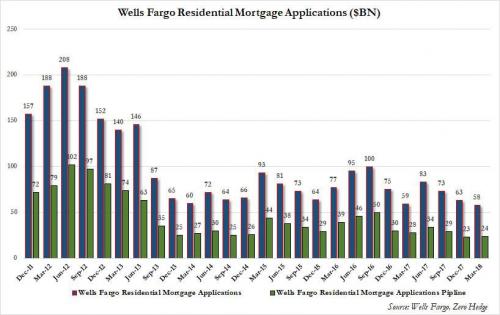Whether due to the collapse of its “reputable” public image following a relentless barrage of client scandals, the Fed’s recent historic crackdown on the company due to its culture of fraud, or simply because the US housing market has sharply rolled over, last quarter we showed that Wells Fargo reported the worst set of mortgage numbers since the financial crisis, with both Mortgage Applications and Mortgage Originations tumbling to levels not seen in a decade.


And since for Wells Fargo, the one-time largest mortgage lender in the US until it was overtaken by Quicken Loans, the housing business has always been its bread and butter, we asked how long the bank would be able to last without engaging in mass, across the board, layoffs.
The answer: roughly over 4 months.
On Friday, Wells Fargo announced it was cutting 638 mortgage employees as the nation’s largest home lender is hit by a crippling slowdown in the business.
“After carefully evaluating market conditions and consumer needs, we are reducing to better align with current volumes,” Wells Fargo spokesman Tom Goyda said in an emailed statement according to Bloomberg.
As we reported back in March that the “Bank Sector IS In Peril As Refi Activity Crashes Amid Rising Rates” and as interest rates have continued to rise, Wells Fargo has been contending with the end of a refinancing boom that helped push profits to a record.
CEO Tim Sloan gave a taste of what was coming when he warned investors of “overcapacity” in home loans at a May conference; then a few weeks later in its second quarter earnings, mortgage fees declined by a third to the lowest in more than five years.
Then the hammer fell, and on Friday Wells announced it was cutting bankers in states including California, Florida, North Carolina and Colorado.
Adding insult to injury, the San Francisco-based bank is operating under a punitive growth ban from the Federal Reserve, the last decree issued by Janet Yellen before her departure. In order to boost profit while growth is restricted., Wells Fargo is seeking expense reductions of $4 billion by the end of next year and a shift to higher-yielding products such as credit cards.













Leave A Comment